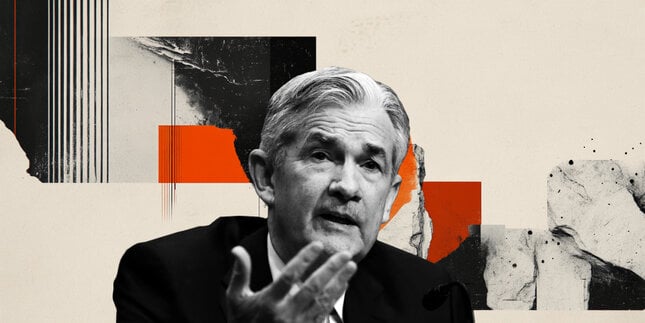Federal Reserve Chairman Jerome Powell comments on the policy outlook and responds to questions from the press following the US Federal Reserve (Fed) decision to hike the policy rate, federal funds rate, by 25 basis points (bps) to the range of 5.25-5.5%.
Follow our live coverage of the Fed's policy announcements and the market reaction.
Fed meeting press conference key quotes
"Inflation expectations remain well anchored."
"We're highly attentive to risks inflation poses to both sides of mandate."
"We have been seeing effects of increases on demand in most rate-senstive sectors."
"We haven't made any decisions about any future meetings."
"The inter-meeting data came in broadly in line with expectations."
"June CPI was welcome but was only one month's report."
"We believe monetary policy is restrictive."
"Stronger growth over time could add to inflation and may require a policy response."
"We're going to be careful about taking too much signal from a single reading on inflation."
"Will be looking to see if signal from June CPI is replicated."
"September decision could be another hike or remaining where we are."
"If we see inflation coming down credibly, we can move down to a neutral level and then below neutral at some point."
"There is a lot of uncertainty around the length of policy lags."
"No one should doubt that we will use tools to bring inflation to target."
"I would say policy is restrictive, more so after today's decision."
The section below was published at 18:00 GMT, right after the FOMC released its monetary policy statement.
The US Federal Reserve (Fed) announced on Wednesday that it raised the policy rate, federal funds rate, by 25 basis points (bps) to the range of 5.25-5.5% following the July policy meeting. This decision came in line with the market expectation.
In its policy statement, the Fed reiterated that policymakers will continues to assess additional information and the implications for the policy.
Market reaction
With the immediate reaction, the US Dollar Index edged slightly lower but managed to hold above 101.00. Investors await FOMC Chairman Jerome Powell's press conference.
Meanwhile, the benchmark 10-year US Treasury bond yield holds steady at around 3.9% and the S&P 500 Index trades modestly lower on the day, losing 0.2%.
Following the decision, US interest rate futures price in an 18% probability of a 25 bps Fed hike in September and a 36.5% probability in November.
Key takeaways from the policy statement
"Inflation remains elevated, policy-setting committee remains 'highly attentive' to inflation risks."
"Recent indicators suggest economic activity has been expanding at a moderate pace."
"Committee is strongly committed to returning inflation to its 2% objective."
"Banking system is sound and resilient."
"Tighter credit conditions are likely to weigh on economic activity, hiring and inflation, extent to which remains uncertain."
"Will continue to reduce its bond holdings as described in previously announced plans."
"Vote in favor of policy was unanimous."
This section below was published at 13:00 GMT as a preview of the Federal Reserve interest rate decision.
- Federal Reserve is widely expected to raise its policy rate by 25 bps to 5.25-5.50%.
- Fed has been struggling to convince markets that they will raise rates at least twice more this year.
- US Dollar valuation could be significantly impacted by Chairman Powell’s comments.
The Federal Reserve (Fed) is expected to raise its policy rate by 25 basis points (bps) to the range of 5.25%-5.5% on Wednesday, July 26 at 18:00 GMT.
Following the release of the monetary policy statement, FOMC Chairman Jerome Powell will comment on the policy decisions and respond to questions in the post-meeting press conference, starting at 18:30 GMT.
The market positioning suggests that a 25 bps July hike is fully priced. Investors, however, are not so certain whether the US central bank will raise the policy rate again before the end of the year, even though the latest Summary of Projections (SEP) revealed that a majority of policymakers saw it appropriate to do so.
Analysts at ANZ think that the terminal rate could be reached with a 25 bps hike in July:
“We expect the FOMC to raise interest rates by 25bps when it meets next week taking the fed funds target range to 5.25-5.50%. That would leave the policy rate in line with our terminal rate forecast.”
“There are signs core inflation is moderating. However, the extent is not clear making it difficult to assess whether it will sustainably track back to 2%. Financial conditions have eased, and uncertainty overhangs the lags with which Fed tightening works.”
Federal Reserve interest rate decision: What to know in markets on Wednesday, July 26
- The US Dollar Index, which tracks the USD’s performance against a basket of six major currencies,consolidates its recvent gains, holds above 101.00.
- The benchmark 10-year US Treasury bond yield started the Fed week on a firm footing and climbed to 3.9% before stabilizing slightly below that level on Wednesday.
- Wall Street’s main indexes opened in negative territory following Tuesday's gains.
- On Thursday, the US Bureau of Economic Analysis will release the first estimate of the second-quarter Gross Domestic Product (GDP) growth. The US economy is forecast to expand at an annual rate of 1.8% in Q2, following the 2% growth recorded in the first quarter.
- The European Central Bank (ECB) is expected to hike its key rates by 25 bps on Thursday.
FOMC speech tracker: Hawkish bias still in place
Federal Reserve officials had a relative hawkish bias in their speeches between their June and July meetings. After having paused interest rate hikes during June, Fed officials helped shape strong expectations of a return to hiking in July with their hawkish vocabulary, with some also hinting at the need for more than one rate hike. Fed Chair Jerome Powell was active with four appearances in this time, two in his semi-annual testimony in the US Congress, and then a couple more overseas in the ECB Forum and on the Bank of Spain in Madrid, mixing balanced with somewhat hawkish remarks. It will be interesting to see if the FOMC board members keep this tone after their meeting on Wednesday.
*Voting members in 2023.
FOMC speech counter
| TOTAL | Voting members | Non-voting members | |
|---|---|---|---|
| Hawkish | 12 | 8 | 4 |
| Balanced | 5 | 3 | 2 |
| Dovish | 4 | 2 | 2 |
This content has been partially generated by an AI model trained on a diverse range of data.
When is the Fed meeting and how could it affect EUR/USD?
The Federal Reserve is scheduled to announce its interest rate decision and release the monetary policy statement this Wednesday, July 26, at 18:00 GMT. This will be followed by the post-meeting FOMC press conference at 18:30 GMT. Investors expect the Fed to lift the policy rate by 25 bps but remain skeptical about additional rate increases later in the year.
Inflation in the US, as measured by the change in the Consumer Price Index (CPI), declined to 3% on a yearly basis in June from 4% in May, the US Bureau of Labor Statistics (BLS) reported earlier in the month. The Core CPI inflation, which excludes volatile food and energy prices, dropped to 4.8% from 5.3% in the same period. On a monthly basis, the CPI and the Core CPI both rose 0.2% but these figures fell short of analysts' estimates.
Following softer-than-expected CPI figures, markets scaled back on hawkish Fed bets and the probability of two more rate increases this year, according to the CME Group FedWatch Tool, dropped to 20% from nearly 40% ahead of the June inflation report.
The US Dollar Index (DXY), which tracks the USD’s performance against a basket of six major currencies, came under heavy bearish pressure and lost nearly 3% in the first two weeks of July. Supported by upbeat Initial Jobless Claims and PMI surveys, DXY managed to stage a rebound ahead of the FOMC policy meeting.
Since a 25 bps hike is already priced in, any hints regarding future rate decisions could drive the USD’s valuation. In case the policy statement reiterates policymakers willingness to raise rates again before the end of the year, the USD could gather further strength. On the flip side, an acknowledgment of softening inflation and worsening growth outlook could be seen as a dovish tone and have the opposite effect on the currency.
Previewing the possible market reaction to the Fed decisions, “falling inflation and worries about global growth leave a narrow probability of Powell signaling the bar is now high for further increases,” says FXStreet Analyst Yohay Elam and continues:
“He would remain data dependent but with the burden of proof on moving to the hawks. In such a scenario, the US Dollar would decline sharply, while Gold and stocks would party. Any hangover would have to wait.”
Eren Sengezer, European Session Lead Analyst at FXStreet, shares his outlook for EUR/USD heading into the all-important Fed meeting:
“A confirmation of one more 25 bps hike after July rate increase could force EUR/USD to stay on the back foot. Especially after the data from Germany and the Eurozone highlighted the loss of momentum in the European economy, reviving concerns over a recession, which could put the European Central Bank (ECB) in a tough spot with regard to further policy tightening. A neutral/dovish Fed tone could hurt the USD and help EUR/USD edge higher but an extended uptrend could be hard to come by before investors see what the ECB has to say on Thursday.”
Eren also outlines the near-term technical developments for the pair:
“EUR/USD faces interim support at 1.1000 (psychological level) before 1.0950 (ascending trend line coming from early June). In case the pair makes a daily close below the latter, 1.0900 (50-day Simple Moving Average (SMA), 100-day SMA) could be tested next.”
“On the upside, 1.1100 (static level, psychological level) aligns as first resistance before 1.1200 (psychological level) and 1.1275 (multi-year high set on July 18). It’s also worth mentioning that the Relative Strength Index (RSI) indicator on the daily chart declined to 50, suggesting that the pair completed the downward correction before deciding on the next directional movement.”
Interest rates FAQs
What are interest rates?
Interest rates are charged by financial institutions on loans to borrowers and are paid as interest to savers and depositors. They are influenced by base lending rates, which are set by central banks in response to changes in the economy. Central banks normally have a mandate to ensure price stability, which in most cases means targeting a core inflation rate of around 2%.
If inflation falls below target the central bank may cut base lending rates, with a view to stimulating lending and boosting the economy. If inflation rises substantially above 2% it normally results in the central bank raising base lending rates in an attempt to lower inflation.
How do interest rates impact currencies?
Higher interest rates generally help strengthen a country’s currency as they make it a more attractive place for global investors to park their money.
How do interest rates influence the price of Gold?
Higher interest rates overall weigh on the price of Gold because they increase the opportunity cost of holding Gold instead of investing in an interest-bearing asset or placing cash in the bank.
If interest rates are high that usually pushes up the price of the US Dollar (USD), and since Gold is priced in Dollars, this has the effect of lowering the price of Gold.
What is the Fed Funds rate?
The Fed funds rate is the overnight rate at which US banks lend to each other. It is the oft-quoted headline rate set by the Federal Reserve at its FOMC meetings. It is set as a range, for example 4.75%-5.00%, though the upper limit (in that case 5.00%) is the quoted figure.
Market expectations for future Fed funds rate are tracked by the CME FedWatch tool, which shapes how many financial markets behave in anticipation of future Federal Reserve monetary policy decisions.
US Dollar FAQs
What is the US Dollar?
The US Dollar (USD) is the official currency of the United States of America, and the ‘de facto’ currency of a significant number of other countries where it is found in circulation alongside local notes. It is the most heavily traded currency in the world, accounting for over 88% of all global foreign exchange turnover, or an average of $6.6 trillion in transactions per day, according to data from 2022.
Following the second world war, the USD took over from the British Pound as the world’s reserve currency. For most of its history, the US Dollar was backed by Gold, until the Bretton Woods Agreement in 1971 when the Gold Standard went away.
How do the decisions of the Federal Reserve impact the US Dollar?
The most important single factor impacting on the value of the US Dollar is monetary policy, which is shaped by the Federal Reserve (Fed). The Fed has two mandates: to achieve price stability (control inflation) and foster full employment. Its primary tool to achieve these two goals is by adjusting interest rates.
When prices are rising too quickly and inflation is above the Fed’s 2% target, the Fed will raise rates, which helps the USD value. When inflation falls below 2% or the Unemployment Rate is too high, the Fed may lower interest rates, which weighs on the Greenback.
What is Quantitative Easing and how does it influence the US Dollar?
In extreme situations, the Federal Reserve can also print more Dollars and enact quantitative easing (QE). QE is the process by which the Fed substantially increases the flow of credit in a stuck financial system.
It is a non-standard policy measure used when credit has dried up because banks will not lend to each other (out of the fear of counterparty default). It is a last resort when simply lowering interest rates is unlikely to achieve the necessary result. It was the Fed’s weapon of choice to combat the credit crunch that occurred during the Great Financial Crisis in 2008. It involves the Fed printing more Dollars and using them to buy US government bonds predominantly from financial institutions. QE usually leads to a weaker US Dollar.
What is Quantitative Tightening and how does it influence the US Dollar?
Quantitative tightening (QT) is the reverse process whereby the Federal Reserve stops buying bonds from financial institutions and does not reinvest the principal from the bonds it holds maturing in new purchases. It is usually positive for the US Dollar.
Information on these pages contains forward-looking statements that involve risks and uncertainties. Markets and instruments profiled on this page are for informational purposes only and should not in any way come across as a recommendation to buy or sell in these assets. You should do your own thorough research before making any investment decisions. FXStreet does not in any way guarantee that this information is free from mistakes, errors, or material misstatements. It also does not guarantee that this information is of a timely nature. Investing in Open Markets involves a great deal of risk, including the loss of all or a portion of your investment, as well as emotional distress. All risks, losses and costs associated with investing, including total loss of principal, are your responsibility. The views and opinions expressed in this article are those of the authors and do not necessarily reflect the official policy or position of FXStreet nor its advertisers. The author will not be held responsible for information that is found at the end of links posted on this page.
If not otherwise explicitly mentioned in the body of the article, at the time of writing, the author has no position in any stock mentioned in this article and no business relationship with any company mentioned. The author has not received compensation for writing this article, other than from FXStreet.
FXStreet and the author do not provide personalized recommendations. The author makes no representations as to the accuracy, completeness, or suitability of this information. FXStreet and the author will not be liable for any errors, omissions or any losses, injuries or damages arising from this information and its display or use. Errors and omissions excepted.
The author and FXStreet are not registered investment advisors and nothing in this article is intended to be investment advice.
Recommended content
Editors’ Picks

AUD/USD weighed down by China, tariffs
AUD/USD remained on the back foot, slipping back to the area of multi-year lows around 0.5950 on the back of mounting fears surrounding tariffs and their impact on the Chinese economy.

EUR/USD refocuses on 1.1000 amid tariffs jitters
EUR/USD reversed two daily pullbacks in a row an d managed to advance to the boundaries of the 1.1000 barrier on the back of fresh weakness hurting the US Dollar and persistent tariff fears.

Gold erases gains, back to the $2,980 zone
Gold prices now lose extra ground and slip back to the area of daily troughs near $2,980 mark per troy ounce following an unsuccesful attempt to maintain the trade above the critical $3,000 level earlier in the day.

RBNZ set for another interest rate cut amid trade tariff uncertainty
The Reserve Bank of New Zealand is on track to deliver a 25 basis point cut to the Official Cash Rate, bringing down the key policy rate from 3.75% to 3.50% following its April monetary policy meeting on Wednesday.

The Fed is looking at a hefty price level
We are still in thrall to tariffs, the faux-macro “data” driving markets. The WSJ editorial board advised other countries to take their tariffs to zero so that Trump’s “reciprocal” tariffs will have to be zero, too. Cute, but no cigar.

The Best brokers to trade EUR/USD
SPONSORED Discover the top brokers for trading EUR/USD in 2025. Our list features brokers with competitive spreads, fast execution, and powerful platforms. Whether you're a beginner or an expert, find the right partner to navigate the dynamic Forex market.



